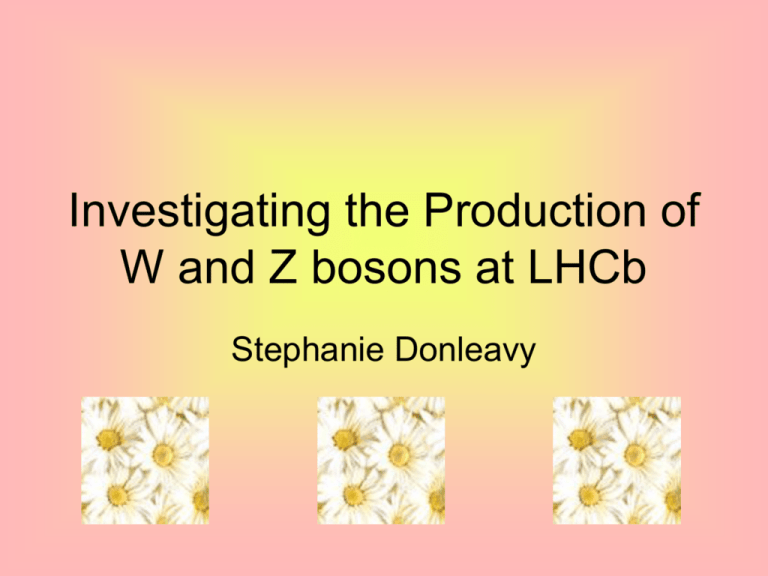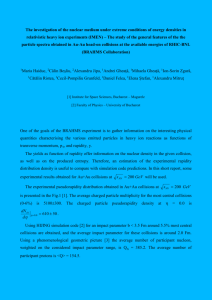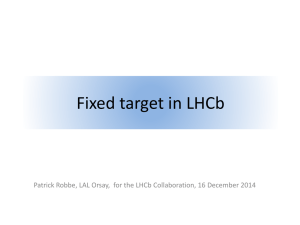Presentation (pp) - Particle Physics
advertisement

Investigating the Production of W and Z bosons at LHCb Stephanie Donleavy Will look at: • Numbers of bosons produced • W and Z production and decay mechanisms • Compare to theory At LHCb • Mainly b physics but many Ws and Zs produced as well. • At an integrated luminosity of 500 pb-1: – 1.5 x 106 W+s, 9.4 x 105 W-s – 1.2 x 105 Z0s (In the LHCb acceptance) Bosons produced at different angles depending on method of production: E.g. ➢ q + q -> forward ➢ q + q -> transverse In LHCb boson seen is mostly produced by q + q interactions • Principle decay modes: I will investigate muon channels Histogrammed parameters: – – – – – Pseudorapidity Rapidity Angular Distributions Transverse mass Invariant mass Plotted for each boson and compared to theory. Use mcfm-5.1 to generate data – A Monte Carlo for FeMto barn processes Theory paper used: Parton Distributions and the LHC : W and Z production. The European Physical Journal C, 14, 133-145 (2000), A.D.Martin, R.G.Roberts, W.J.Stirling, R.S.Thorne Rapidity Theory Rapidity Distributions for Ws E pz 0.5 ln Rapidity: ( E p ) z It is a measure of a particle's angle wrt the beam axis Rapidity Results (Y-axes are just number of particles) PDF sets - motivations • In regions where the PDF is most accurate the most precise test of the standard model can be made • In regions without accurate PDF sets, data input to theory to improve knowledge and prediction capability PDF sets used : cteq6m and mrst2001 Comparing different sets Different PDF sets have different errors for different regions of rapidity •Due to different theoretical assumptions Program made to plot: • pseudorapidity of lepton and / or neutrino • rapidity of boson or lepton The following graph was produced of rapidity to look at PDF errors in different regions Errors greater at central rapidities Plots of Percentage error •Percentage errors are much lower in central regions of rapidity •Ratios mean that some unknowns cancel out so overall error is much less Comparing MRST and CTEQ Plots were made of pull using the following definition: Overall Plot shown below: •Width is not equal to 1 so separate plots were made for each process to analyse problem. •Errors were found not to be independent. Conclusions from PDF Sets Plots made of Pull vs Pseudorapidity for each process: PDF Sets found to be mostly within ~8% of each other's predictions. Main differences occurred in ratio plots at high values of rapidity / pseudorapidity - where there is a lack of data and theoretical assumptions are made. CTEQ errors generally larger than MRST – assumption of u-d sea ratio Further Plans: For continuation to thesis, •~2.5 fb-1 of data expected •Use LHCb code •Look at selection of W/Z candidates •Understand trigger and background EXTRA PLOTS • Angular distribution: Theta is the angle of the lepton's direction with respect to the boost direction in the rest frame of the W. Acceptances LHCb acceptance is 1.8 - 4.9 in Pseudorapidity Boson Acceptance (%) Crosssection (nb) Acceptance cuts are made on lepton From generator using cteq6m W+ 27.6 108.75 +2.61 / -2.94 W- 24.1 79.98 +2.06 / -2.38 Z0 13.9 57.78 +1.32 / -1.59







